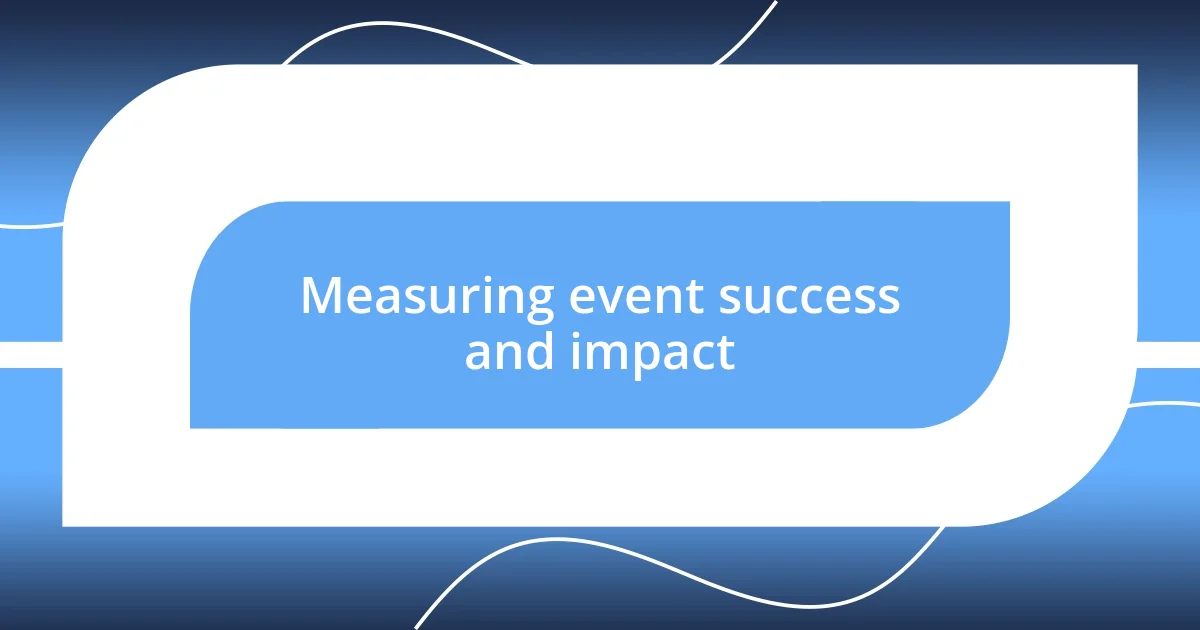Key takeaways:
- Club spirit fosters unity and resilience among members, enhancing participation and motivation during challenging times.
- Planning impactful events with clear objectives, member engagement, and feedback mechanisms improves overall experiences and builds community.
- Collaborative events and themed activities ignite excitement and deeper connections, while social media promotes engagement and storytelling, enhancing event attendance and impact.

Understanding club spirit importance
Club spirit is the heartbeat of any organization; it’s what binds members and fosters unity. I remember my first event with my club—everyone was nervous, but by the end, we were laughing and celebrating together. It hit me then how a shared experience can create an emotional connection that transcends individual differences.
When members feel a strong sense of belonging, they’re more likely to actively participate and invest their time and energy. I often wonder: how can we cultivate that feeling of inclusivity? It’s through engaging events that celebrate our achievements and acknowledge every member’s contribution, sparking a sense of pride in what we stand for together.
Moreover, a vibrant club spirit can even enhance morale and motivation during challenging times. I recall a particularly tough period for our group when enthusiasm was waning. We organized a team-building retreat, and I still remember the energy of that weekend. It reminded me that fostering club spirit isn’t just about fun; it’s about resilience, hope, and the understanding that we are stronger together.

Planning impactful events
When it comes to planning impactful events, having a clear purpose is essential. I’ve found that setting specific goals for each event helps in crafting experiences that resonate deeply with members. For example, during a charity fundraising event, we focused on not just raising money but also building camaraderie by incorporating team challenges. This dual focus encouraged participation and heightened the energy in the room, creating a bond among everyone present.
Here are some key elements to consider when planning impactful events:
- Define clear objectives: Know what you want to achieve, whether it’s fundraising, awareness, or simply boosting club morale.
- Engage members in the planning process: Getting input and ideas from club members fosters ownership and excitement.
- Create a theme: A relatable theme can unify the event and enhance engagement, making it memorable.
- Include networking opportunities: Allow time for members to connect and share experiences—this builds community.
- Make it interactive: Activities that involve participation encourage connection and investment in the outcome.
- Gather feedback afterward: Listening to members’ insights helps refine future events and demonstrates that their opinions matter.
Planning with intention not only enriches the experience but also reinforces that we are all in this journey together.

Engaging members through collaboration
Engaging members through collaboration is a powerful way to enhance club spirit. I remember when our club decided to hold a collaborative event with another local organization. This wasn’t just about joining forces; it was about blending our members’ unique skills and perspectives. Working side by side with others instantly transformed the atmosphere, filling the room with excitement and fresh ideas. The event became a melting pot of creativity, showcasing what we could achieve together—something far greater than we could have accomplished independently.
One of the most rewarding aspects of collaboration is the opportunity for members to share their talents and insights. I’ve seen firsthand how a workshop, where everyone takes the lead on a particular activity, fosters a deeper connection among participants. I vividly recall a session where one of our quieter members led a discussion on her passion for photography. It was incredible to watch her confidence grow as she engaged with others, sparking lively conversations and inspiring creativity across the group. Everyone left that day feeling a renewed sense of belonging, as if we had collectively painted a vibrant picture of our capabilities.
Moreover, collaboration breathes life into our events by ensuring diverse voices are heard and valued. I often think about a community service project we organized, where we invited members to propose their ideas for outreach. The sheer range of suggestions—from organizing a food drive to creating an art project for local schools—filled me with pride. Not only did it empower individuals, but it also nurtured a sense of unity as we came together to implement those ideas, making each member feel like an integral part of our mission.
| Aspect | Individual Engagement | Collaborative Engagement |
|---|---|---|
| Input | Limited, often one voice | Diverse, everyone contributes |
| Ownership | Lower, less investment | Higher, shared responsibility |
| Innovation | Less variety | Increased creativity |
| Connection | Surface-level | Deeper relationships |

Creating themed events for excitement
Creating themed events has always been a game changer for me in unleashing excitement within our club. One summer, we hosted a ‘Decades Night,’ where everyone was encouraged to dress up and bring dishes from their favorite decade. The energy was palpable as members donned bell-bottoms, poodle skirts, and even grunge attire—it felt like stepping into a time machine! Suddenly, it wasn’t just an event; it was a time-traveling adventure that sparked laughter and nostalgia, allowing members to share stories from their pasts.
In another instance, we planned a ‘Cultural Festival’ themed event, where members brought elements from their backgrounds to share. I still remember the warmth of seeing my friends introduce dishes, music, and crafts from their cultures—creating a vibrant tapestry of experiences that fostered deeper connections. The aroma of different cuisines wafting through the air stirred curiosity in everyone. Who wouldn’t want to taste a homemade dish while learning about its significance? It was more than just food; it became a celebration of our diversity and unity.
What I find truly magical about themed events is their ability to ignite participation in unexpected ways. When we introduced a ‘Superhero Day’ and encouraged members to come dressed as their favorite heroes, it led to spontaneous team-building games and storytelling. Who knew a costume could unlock hidden talents? I watched as some members transformed, taking on roles that made them shine in ways I hadn’t seen before. The costumes weren’t just fabric; they were gateways to creativity, self-expression, and connection, bringing an electrifying spirit to our club that lingered long after the event was over.

Using feedback to improve activities
Gathering feedback is invaluable for refining our activities. After an event, I often sit down with members to discuss their experiences. I remember a time when we hosted a talent show; while the enthusiasm was high, several members pointed out that we could improve the way performances were scheduled. By listening to these insights, we managed to create a more organized structure for our next show, allowing everyone to showcase their talents without feeling rushed. It’s amazing how small adjustments can elevate the overall experience for everyone involved.
One method I’ve found particularly effective is using anonymous surveys to collect honest feedback. I recently implemented this after a workshop series we ran a few months ago. The responses highlighted that the hands-on activities really resonated with participants, but some felt overwhelmed by the information presented in the lectures. This revelation made me realize the importance of striking a balance. In future workshops, I simplified the content and increased interactive elements, which made attendees more engaged. Have you ever noticed how a simple tweak can turn good into great?
Lastly, I like to share feedback with the team openly. When discussing the insights we gather, I emphasize the idea that every opinion matters, creating a culture of continuous improvement. For example, after a community event, I openly praised a member who suggested a new approach to our outreach strategy. This recognition boosted not only their morale but inspired others to share their thoughts freely. I’ve seen how fostering an environment where feedback is welcomed can lead to collective growth, ensuring that every activity we organize becomes a little better each time.

Promoting events through social media
Social media has transformed how I promote our events. I’ve discovered that creating visually appealing content—like eye-catching graphics or short, engaging videos—sparks interest and encourages members to participate. For instance, when I recently organized a movie night, I shared a teaser video showcasing clips of our favorite films and some playful behind-the-scenes banter. The excitement on our group chat was palpable, and I think it made everyone feel they were part of something special right from the start.
I’ve also found the power of storytelling on social platforms to be incredibly effective. During our last charity drive, I shared daily updates featuring heartfelt testimonials from beneficiaries. I vividly remember one post where I included a quote from a young girl who received support, and it resonated deeply with our members. How can one not feel compelled to join an event when they know their participation makes a direct impact? This authenticity not only amplified our message but also fostered a sense of community and purpose.
Engaging with members directly through comments and messages also plays a crucial role. I once noticed someone asking about the details of an upcoming picnic on our Instagram post. I jumped in to respond, adding a personal touch by sharing my favorite picnic dish and inviting them to bring theirs. This small interaction turned into a thread where others chimed in, sharing their culinary favorites. It made the event feel like a collaborative effort, and I could sense the growing anticipation among members. It’s moments like these where I truly see how social media can blend promotion with genuine connection.

Measuring event success and impact
To effectively measure the success of an event, I always look at both quantitative and qualitative data. For instance, after one of our sports tournaments, I tracked attendance numbers and participant feedback. An increase in participation from the previous year combined with positive comments about the atmosphere helped me see that we were on the right path. But what truly made my heart swell was hearing a participant say they felt “a real sense of belonging.” Isn’t that what we strive for?
One tool I find indispensable is analyzing post-event engagement. After hosting a community workshop, I monitored follow-up interactions on social media and within our group chats. The excitement lasted for days as people shared photos and stories from the event. It made me realize that the impact goes beyond the day itself; it lingers in conversations and shared experiences. How often do we consider the echo of an event in our members’ lives?
Additionally, I believe in creating metrics that resonate personally with our mission. After a recent community service project, we celebrated our collective efforts by highlighting the number of volunteer hours logged and the smiles we brought to those in need. Sharing these results not only motivated our members but also reinforced our purpose. When I received messages about how impactful the experience was—one member even said it “changed their perspective”—I knew we’d achieved something significant. Isn’t it rewarding to see the tangible effects of our hard work?














